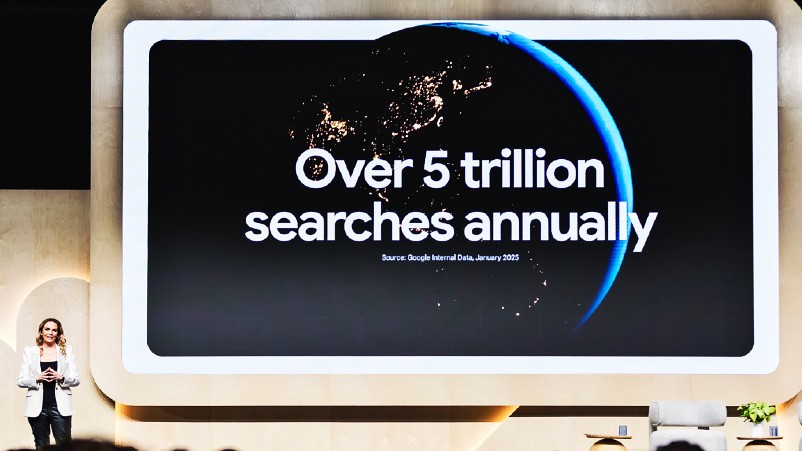Google pushes YouTube-search-Pmax bundle, sharper predictive tools, streaming to shopping play as gen AI bites legacy search

Google ANZ MD, Mel Silva on stage at Google Marketing Live Sydney 2025
Google amped up shiny new predictive tools, a sharper commerce through-line and a search-YouTube-Pmax bundle to marketers in Sydney last week, with plenty of customer case studies touting brand-to-demand ROI prowess. But with search increasingly expected to be displaced by generative AI tools – Gartner predicts a 25 per cent drop in search by next year, HubSpot’s chief is already citing 70 per cent drops in traffic off the back of AI-powered Overviews – plus all the regulatory scrutiny Google’s business model is under, can the narrative stick even for 12 months? Google insists there's plenty of clicks left in the tank.
Predictive AI advancements across its search platform and advertising toolkit, a reconstructed narrative to position Google search and YouTube into one all-encompassing, streaming-to-shopping marketing funnel, a bullish take on search’s ongoing dominance – despite persuasive global commentary to the contrary and acknowledgment how we search is changing – and case studies showcasing marketing ROI from brand to demand made up Google Marketing Live last week.
Google’s business model is getting a shake-up, its search dominance is under threat, and the execs and engineers know it. No one can have missed the way regulatory action globally is ramping up against Google on all sides against its dominant search and digital advertising position. Australia’s own ACCC has been working hard to build the case for reforms under a new digital competition regime with better consumer protections as well as a stronger hand and penalties for anti-competitive behaviour by digital platforms. The class actions are equally coming thick and fast from publishers everywhere from Australia to Canada against Google’s alleged systemic takedown of independent publishers for bid rigging and collusion to global digital ad monopolistic behaviours.
Then there’s the transformation of search itself, both through Google’s own ad tools, such as AI-powered Performance Max (PMax), or user-facing innovations like AI Overviews, or ChatGPT’s growing dominance as an alternative search platform for consumers. In addressing its own event in Sydney last week, HubSpot CEO, Yamini Rangan declared Google AI Overviews have slashed search traffic by up to 70 per cent. It’s just one example of the many ways search’s dominance and the old playbook of keyword-driven SEO and paid search is being curbed in the age of AI, Rangan argued. Gartner, meanwhile, predicts global search volume will drop 25 per cent by 2026 as AI tools replace basic queries.
Such a situation has also put soaring search costs in the spotlight. Reports to Mi3 from Sparro by Brainlabs showed search and PMax costs have surged this last year, rising as much as 30+ per cent quarter-on-quarter in search, and upwards of 20 per cent on PMax. Some of it is blamed on a surge in demand from marketers. Some of this is also reportedly down to falling clickthrough rates or organic search as Google shifts to AI Overviews. Sparro by Brainlabs co-founder, Cameron Bryant, told Mi3 he agreed there’s a direct link to rising prices and Google and Meta’s shift to “black box’ models in PMax and Advantage+, which leverage AI and machine learning algorithms to place ads across their properties.
Google doesn’t want to be first, but it does want to dominate
But whatever frays it faces, and whatever shape-shifting is occurring to search as a channel and information-finding tool, the message at Google Marketing Live was Google is going to be all over it. Be that AI innovation, changes in how consumers want to search, or the new-look “streaming to shopping” replacing the traditional marketing funnel. Even if it’s not going to be the first tech player to get it down pat.
“We are focused on building it right, not just building it fast. Google wasn’t the first search engine, or the first browser, we weren’t the first in online media or email platforms. We weren’t first with any of these things in the market – but we have always had a relentless focus on building product that meets the consumers where they need,” Google MD for ANZ, Mel Silva, said in her opening speech. “That’s what we are doing with AI as well: Bold and responsible.
“We are uniquely positioned to led in this era…. This is a decade worth of investment in AI leadership and you are really starting to feel the tangible benefits in your hands today.”
On the search front, the big macro shift Google spies is increasing swathes of voice, visuals and live interactions searching. For example, Google Lens searches are up 40 per cent to over 20bn per month, 8bn more than six months ago. Google also claimed one in five of these searches “show commercial intent”. Google’s Gemini personal assistant got a mention too.
“In the era of AI, how people discover information and make decisions is change,” Silva said. “I see it, snap it, buy it – it’s the kind of experience we need to think about for consumers.”
Other recent AI innovations for Google users include AI Mode, now available in the US, with advanced reasoning and multi-modality to ask follow-up questions and gain links to websites.
Then there’s AI Overviews, which Google launched 12 months ago, pushing organic search links further down the page in favour of larger, non-branded AI overview recommendations at the top. Google said AI overviews now has 1.5bn users globally every month while in the US and India, and is seeing 10 per cent growth in these queries once it starts to show Overviews. AI Overviews are expanding to desktop in the US, and to mobile and desktop in select countries in English. It's expected to come to Australia later this year.
Advertiser AI
Speaking of keywords, one major advertiser announcement at Google’s Sydney event was AI Max for Search, which launches on Search Campaign Management 360 in a few weeks. Google pitched this as a keywordless solution which learns from an advertiser's landing pages and creative content to anticipate user needs. It claimed advertisers in beta trials saw a “typical” 27 per cent increase in conversions at a similar CPA. One was Australian education marketplace, Candle Fox, reporting conversions increase of almost 30 per cent with a 17 per cent reduction in cost per conversion using AI Max, leading to a +13% increase in gross profit for the business.
More broadly, shifting to predictive, AI-powered intelligence was the theme for advertisers here from Google’s AI enhancements. Over 90 product enhancements to Performance Max (PMax) were shipped in the last year, reportedly boosting conversions by 10 per cent on average. These include a new Channel Performance Reporting feature. Demand Gen for Google Ads campaign management also had 60+ product improvements in the last year, leading to a 26 per cent improvement to conversion value.
Convincing brands of the ROI on PMax – for a similar ROAS – was a key part of last week’s narrative. One marketer on stage was The Iconic’s CMO, Joanna Robinson, who shared the retailer’s transition to PMax, starting with “robust vetting” of results through multi-cell testing in New Zealand. This delivered +22 per cent in terms of revenue while achieving the same ROAS, she said.
The move to PMax came off the back of a prevailing belief The Iconic had perhaps reached the limits of search and shopping, precipitated by Covid-19 and the rapid shift of all retailers to ecommerce channels.
“We knew consumer and search behaviour had shifted over three years and we needed to diversity our media mix to reflect this,” said Robinson. “We were also coming off the back of our recent marketing campaign, ‘we’ve got you looking’, so we know we had some really strong brand assets to feed into the Google ecosystem.”
The test results “proved we could drive volume without sacrificing efficiency,” Robinson told attendees. All shopping spend in 2025 has now been transitioned to PMax as each category demonstrated similar results.
“It proved Google can drive substantial incremental growth for company the size of The Iconic. We happily reported an NMV increase of +9.4 per cent in Q2 24. We’re just about to finish second quarter, seeing strong sales and profit and I think Google and PMax have been an instrumental part of that.”
Sticking by search – even if it means hooking in streaming and scrolling
Then there’s the repositioning of search plus YouTube Google was keen to land with the 600+ people at Google Marketing Live Sydney. Firstly, Google is adamant its search offering remains relevant and solid.
“There have been a few headlines recently about what's happening in search and all these changes that might be coming to search. So let's just hit it and have a little chat about it right now,” Silva said on stage. “I’ll start with this number: 5 trillion searches globally every single year. That's just search. That's not even counting the number of searches taking place on YouTube. We are still seeing query growth on Google Search… and according to a survey, again with Ipsos, 79 per cent of consumers in Australia report using Google or YouTube on a daily basis. That is more than any other digital platform. What about younger users? The 18 to 24s are the ones firing off the most search queries daily than anyone else. Search still is combining that deep and vast scale with consumer intent and an unwavering trust.
“We've asked advertisers as well, and Australian advertisers are more likely to say that Google search and YouTube drives business growth more than any other digital platform.”
Nevertheless, against this insistence, Silva acknowledged Google has to recognise behaviour has changed. “We have had to change along with it,” she continued.
One of these more self-serving shifts is increasing numbers of consumers moving back and forth between search and YouTube – from discovery through to purchase decision. During the recent Australian Federal Election, 19m visited the Australian Electoral Commission’s website from either Google or YouTube.
“The old rules just don’t apply anymore, people are moving back and forth across these platforms throughout various stages of the purchase journeys,” Silva said. “The new reality is consumer choice is defined by four key behaviours we are seeing: Streaming, scrolling, shopping and searching.”
According to Ipsos data, YouTube reaches 19m reach online adults every month, however on connected TVs, scrolling elsewhere is evident. YouTube shorts has 2bn monthly active users globally, for instance, and more than doubled its viewcount to 70 billion views in the past two years. Silva pointed to more than “1bn shopping moments happening on our platforms every single day”.
“Even when social media platforms are in the mix, we’re seeing 65 per cent of the time, people are viewing on Google or YouTube first. In many cases, social platforms are capturing that intent from Google and frankly, selling it back to you as discovery. When people do discover on social, they still use search to make that final purchase decisions. Seventy per cent of people are using Google search to evaluate the products they found on social media,” Silva added.
It’s the narrative for now. But it won’t be in the near term if tech expert commentary is anything to go by. According to Statcounter, Google’s share of global search traffic fell to 89.7 per cent in March 2025 – a downward trend that started in October 2024. This marks the first sustained drop below 90 per cent in a decade.
“Generative AI solutions are becoming substitute answer engines, replacing user queries that previously may have been executed in traditional search engines,” Gartner Vice President Analys, Alan Antin, said in February last year. “This will force companies to rethink their marketing channels strategy as GenAI becomes more embedded across all aspects of the enterprise.”








